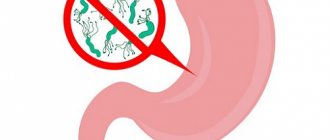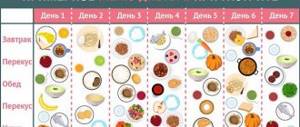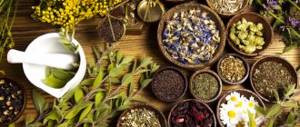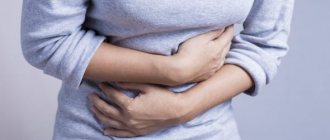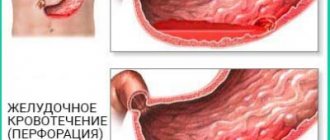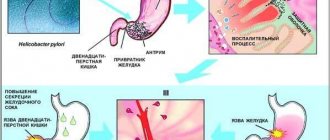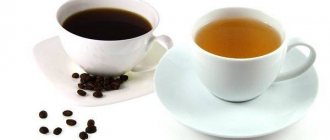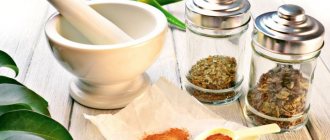Methods for diagnosing gastric ulcer - differential diagnosis
A gastroenterologist is involved in identifying and treating the pathology in question . During the initial visit, the specified specialist clarifies with the patient the nature of the pain, the presence of other complaints, as well as the duration of the discomfort.
Based on the collected medical history, the doctor can only assume the presence of a gastric ulcer. However, it is possible to accurately verify this disease only through instrumental and laboratory procedures .
Esophagogastroduodenoscopy with approximately 95% probability can confirm or refute a gastric ulcer.
The main attribute of the study is a flexible probe with a camera at the end; it is inserted through the pharynx into the esophagus and stomach. Using a gastroscope, a specialist can establish the parameters and exact localization of the ulcer, its depth and shape, as well as record violations of the contractile function of the stomach.
This manipulation is carried out on an empty stomach, at least 8 hours after the last meal. It is also not recommended to drink water during the specified period of time.
In the event that emergency gastroscopy is required, the patient’s stomach is first washed, and only then a probe is inserted. If necessary, during this manipulation, a microscopic piece of stomach tissue is taken for further testing under a microscope.
If there are contraindications to the procedure described above, the patient is sent for an X-ray examination using a dye . This technique is less informative than the previous one.
In addition, during the examination for the presence of gastric ulcer, the following diagnostic measures are carried out:
- Tests for the presence of the bacterium Helicobacter pylori. They are required to be taken when an ulcerative defect is identified. Blood, feces, or exhaled air (urease test) can be used as the test material.
- General blood and urine analysis . In case of peptic ulcer, these tests will indicate the presence of inflammatory processes in the body.
- Testing stool for occult blood . Helps identify chronic or acute blood loss in the gastrointestinal tract.
- Ultrasound examination of the abdominal organs . They are carried out to identify concomitant ailments.
- Studying the level of acidity of the gastric environment using intragastric pH-metry. This manipulation can be performed during esophagogastroduodenoscopy. In some cases, patients may be prescribed a 24-hour pH measurement study, during which a nasal probe is used.
If gastric cancer is suspected (peptic ulcer prone to malignancy), which is similar in its symptoms to peptic ulcer disease, the patient is referred for consultation to an oncologist .
If the ulcerative defect provokes perforation of the stomach wall, immediate surgical intervention .
Perforated ulcer of the stomach and duodenum
Sudden onset of severe pain in the epigastric region, quickly spreading throughout the abdomen. The patient's position is forced - with legs bent and brought to the stomach. Dry tongue, thirst. Breathing is frequent and shallow. Severe tension in the muscles of the anterior abdominal wall; the abdomen does not participate in the act of breathing. Positive signs of peritoneal irritation. Hepatic dullness is not detected. In the future, it is possible to improve the general condition and reduce pain (covered perforation). A plain X-ray of the abdomen shows the presence of gas in the abdominal cavity. Over time, signs of diffuse peritonitis progress.
First aid
Rest, cold on the epigastric region. Hunger. Urgently seek medical help.
First aid
Urgent hospitalization. If there is a delay in providing medical assistance, insert a gastric tube to continuously suction the contents from the stomach.
Medical emergency care
Peace. Ice pack on the epigastric region. Intramuscularly 0.5 ml of 0.1% atropine solution. Urgent evacuation to a medical center or hospital in an ambulance, while lying on a stretcher, accompanied by a doctor. For long-term evacuation - antibiotics, suction of stomach contents through a tube.
Confirmation of the diagnosis: anamnesis, examination, plain radiography of the abdominal cavity, revealing the presence of free gas under the dome of the diaphragm; in the absence of this cardinal sign and the presence of signs of irritation of the peritoneum, perform fibrogastroduodenoscopy, pneumogastrography with repeated radiography of the abdominal cavity, or contrast gastrography with a water-soluble X-ray contrast agent.
In the preoperative period - infusion therapy, a single administration of antibiotics (aminoglycosides, cephalosporins). Scope of the operation: suturing the perforation, drainage of the pelvic cavity with a double-lumen tube for peritoneal dialysis, decompression nasogastrointestinal intubation.
In case of a perforated duodenal ulcer, when there are no signs of diffuse peritonitis (no later than the first 6 hours after perforation), bilateral subphrenic truncal vagotomy with pyloroplasty is indicated.
Instructions for emergency care for acute diseases, injuries and poisonings. Part I
To accurately interpret changes when analyzing an ECG, you must adhere to the decoding scheme given below.
Surgical instrument sets - description
All surgical instruments can be used to create sets that will allow you to perform typical surgical procedures. There should be connecting instruments on the operating nurse’s instrument table - i.e. those that only the operating nurse uses: scissors, anatomical tweezers are small.
Tooth surfaces, dental formula
For the convenience of describing the features of the relief or localization of pathological processes, 5 surfaces of the tooth crown are conventionally distinguished.
Conservative treatment of gastric ulcer - effective therapeutic methods, drugs
In the treatment of this pathology, an integrated approach is needed, including non-drug and medicinal effects.
If the development of ulcerative defects is associated with Helicobacter pylori, the emphasis in treatment is on the complete elimination of these microorganisms. For this purpose, antibiotic therapy is carried out using drugs based on tetracyclines, macrolides, and penicillins .
For HP-negative gastric ulcers, antibacterial agents are not prescribed.
Regardless of the presence of harmful bacteria, drug therapy for gastric ulcer involves taking the following drugs:
Medicines that help normalize the acid-base balance:
- Antacids - Almagel, Phosphalugel, Rutacid, etc. Their main task is to neutralize hydrochloric acid. Such remedies act quickly enough, and this helps to quickly eliminate pain. However, regular use of such drugs causes a response from the stomach: trying to avoid alkalization, secretory cells produce even more acid, which ultimately leads to an even greater increase in acidity. Thus, it is problematic to normalize the pH in the stomach with antacids alone.
- Proton pump inhibitors - Rabeprazole, Omeprazole. The movement of hydrogen ions, which are part of hydrochloric acid, is blocked by the medicinal substances in question. This helps to interrupt the chemical cycle of production of said acid.
- H2-histamine receptor blockers - Famotidine, Ranitidine.
Drugs that protect the gastric mucosa
They are aimed at increasing mucus and bicarbonate production, as well as normalizing pH balance.
The most prominent representatives of this group of medications are Cytotec and Misoprostol.
Some of these agents have the ability to form a protective film in the stomach - Tripotassium bismuth dicitrate.
Drugs that help improve contractile functions of the stomach
Domperidone, Motilium, Metoclopramide - they are called prokinetics . Thanks to them, food does not stay in the stomach for a long time, and the patient does not have the urge to vomit.
Antispasmodics
Prescribed for the purpose of relieving pain by eliminating muscle spasms - Drotaverine, Scopolamine.
Sedatives
This is valerian extract, Tenoten. Prescribed if the patient has psycho-emotional disorders.
Before prescribing such drugs, it is recommended to visit a psychotherapist .
Physiotherapy
In the event that this pathology proceeds without complications and is not in the acute stage, the doctor may prescribe physiotherapeutic procedures based on thermal effects. The most popular of them are ozokerite therapy, paraffin therapy, and electrophoresis.
Thermal effects help eliminate heartburn, nausea, and also minimize or completely eliminate pain.
The course of such treatment is 10 procedures, but often, after the 3rd session, patients feel relief.
What to do during an attack of peptic ulcer?
First aid involves the following measures.
The patient requires complete rest.
During an exacerbation, you should temporarily abstain from eating food. When the condition improves, it is important to adhere to a strict diet based on slimy soups and cereals.
You should not warm your stomach. If there is a serious suspicion of a perforated ulcer, on the contrary, it is advisable to apply a container of cold water to the abdomen. The cold will help slow the bleeding.
With increased acidity, antacids also help well - Maalox, Rennie, Gestal.
Please note, however, that choosing medications at your own risk is dangerous. It is best to consult a doctor in advance and find out exactly what is needed to stop the attacks.
Probably, some readers will have a question: what is meant by a fading exacerbation?
The mentioned term should be understood as the persistence of endoscopic signs of intense inflammation in the absence of corresponding clinical symptoms.
To put it simply, a fading exacerbation is a period in which pronounced signs of the disease are still detected by hardware diagnostics, but are no longer felt by the patient himself.
Gradually, the ulcer scars and for the time being allows the patient to live a normal life. Don’t worry, long-term remission is quite achievable (see article Is it possible to cure an ulcer?).
Peptic ulcer is a chronic disease of the stomach or intestines. From time to time it enters an acute phase of its development. The frequency of such exacerbations depends on the lifestyle and nutrition of the patient himself. It is necessary to learn to recognize an attack of an ulcer in time so as not to provoke irreversible consequences.
Basics of diet for stomach ulcers
One of the main aspects of successful treatment of gastric ulcers is diet.
During exacerbations of the disease in question, you should refuse to eat and follow all the recommendations of the gastroenterologist.
If a gastric ulcer is at a quiescent stage, you should still monitor your diet.
To date, it has not been proven that liquid food improves the condition of a patient with a stomach ulcer, but eating boiled vegetables clearly will not harm the diseased organ.
Therefore, when planning your daily menu, patients with stomach ulcers should consider several points:
- Salty, fried, spicy, fatty, smoked foods irritate the gastric mucosa and provoke pain and other discomfort. You should avoid such products. Cooked food should not contain spices or vinegar, and such food should be consumed without adding various sauces and ketchups.
- Ready-to-eat products must have an adequate thermal regime: hot or cold food is unacceptable in case of peptic ulcer.
- You need to eat often (5-6 times a day), but in small portions to avoid stretching the stomach. In the evening, it is better to refrain from eating, because... this will trigger the production of hydrochloric acid.
- Alcohol and smoking lead to a relapse of this disease. Therefore, you should get rid of these bad habits. Caffeinated and carbonated drinks also negatively affect the stomach.
Note! you should exclude citrus fruits, vegetables with coarse fiber (primarily cabbage), and cranberries from your diet
An attack of a stomach ulcer - what to do to relieve it?
Published: June 18 at 12:55
Are you still suffering from GASTRITIS? It is not the effect that needs to be treated, but the cause,” says Olga Kirovtseva.
Dull or aching pain in the stomach is periodically replaced by pronounced cutting sensations that characterize an acute attack of an ulcer. This condition can be caused by seasonal weather changes, heavy physical activity, drinking alcohol, fatty or spicy foods in large quantities. That is why gastroenterologists always warn their patients about possible exacerbations, recommending that they lead a measured lifestyle, adhere to a diet, and completely give up alcohol and cigarettes. But not all people follow these recommendations, which is why attacks of stomach ulcers occur with some regularity.
How to relieve an ulcer attack on your own?
Naturally, when an attack of peptic ulcer occurs, it is best to immediately call a doctor. But sometimes this is not possible, for example, when a person is outside the city. In this case, you have to eliminate the unpleasant symptoms with the help of available medications or improvised means.
No more bloating, diarrhea, heartburn, heaviness and other symptoms of GASTRITIS! Our readers are already using this method to treat gastritis. Read more
First of all, it is necessary to provide the patient with complete rest. You should also temporarily, at least until examined by a doctor, refuse to eat any food. For medications, you can take a couple of tablets of No-Shpa or Papaverine. The fact is that the symptoms of an attack of a stomach ulcer are based on antispasmodic pain caused by contraction of the walls of the muscle sac, and No-Shpa and Papaverine are antispasmodics. At the same time, they should be taken very carefully by people suffering from hypotension, as a decrease in blood pressure is possible.
If there are no medications, regular baking soda will do. which quickly reduces acidity levels and relieves pain. But it is not recommended to abuse sodium bicarbonate, since with constant use it provokes an even greater release of hydrochloric acid. Soda is only allowed to relieve acute symptoms of the disease when there are no medications available. After this, you should immediately go to the doctor.
A good remedy for an acute attack of ulcers is the mashed yolk of a fresh chicken egg, mixed with cocoa powder, honey and butter, taken in approximately the same volume. A homogeneous mass is taken every 3 hours, 1 tbsp. spoon. You can eat food after taking the medicine no earlier than half an hour later.
A mixture prepared according to this recipe very quickly relieves the symptoms of the first attack of peptic ulcer. To exclude relapses, it is recommended to continue taking it for two weeks.
By secret
- Are you tired of stomach pain, nausea and vomiting...
- And this constant heartburn...
- Not to mention bowel disorders, alternating with constipation...
- It’s sickening to remember the good mood from all this...
Therefore, we recommend that you read the story of Olga Kirovtseva about her recovery from GASTRITIS. Read more "
Surgical treatment of pathology - types of operations and indications for their performance
Routine surgical treatment of the pathology in question is carried out in the following cases:
- No improvement from conservative therapy for 2 years.
- Degeneration of a peptic ulcer into a cancerous neoplasm.
- Severe blood loss.
- Scar formation in the stomach, which negatively affects its functioning.
- The appearance of a through defect in the area where the ulcer is located.
Keep in mind: If a doctor, after studying the results of the examination, advises the patient to undergo surgery, you should listen to his words. Elective surgery carries fewer risks than emergency surgery.
Emergency manipulations on the stomach in case of gastrointestinal tract disease are indicated in the event of exacerbations that threaten the lives of patients. However, this type of operation is not always effective.
Surgical treatment of gastric ulcer can be presented in the form of the following procedures:
- Suturing an ulcer . In practice they are used extremely rarely. The perforation hole in this situation is closed by applying double-row interrupted seromuscular sutures.
- Gastric resection . It involves removing the entire stomach or individual parts of it. Such manipulation is carried out endoscopically or openly.
- Gastroenterostomy . Often, the procedure in question is performed together with gastric resection. The operator forms an anastomosis between the stomach and small intestine, thereby ensuring the movement of the food bolus through the gastrointestinal tract.
- Vagotomy . It consists of an invasive effect on the vagus nerve, as a result of which the aggressive effect on the gastric mucosa is minimized.
Exacerbation of a stomach ulcer - how does it go?
An attack of peptic ulcer is most often caused by negative factors:
- seasonal changes in nature in spring or autumn;
- excesses in nutrition - for example, overeating during a feast;
- consumption of inappropriate products;
- drinking alcohol;
- smoking;
- heavy physical activity.
What attacks occur with an ulcer? The following symptoms come to the fore:
- muscle tension in the stomach area;
- strong pain;
- increased sweating;
- dyspeptic symptoms - heaviness in the stomach, nausea, sour vomiting that brings relief;
- problems with bowel movements.
Folk remedies for the treatment of peptic ulcer
Traditional medicine for this pathology cannot replace drug treatment.
If the doctor approves a particular prescription, it must be used as an addition to traditional treatment .
The following folk recipes are the most popular in the treatment of peptic ulcers:
- Fresh potato juice . This vegetable is grated, and the resulting puree is squeezed through cheesecloth. The first week they drink 20 grams. this juice before every meal. Subsequently, with each subsequent week, the indicated portion is doubled. If discomfort occurs, the portion is reduced or completely canceled. The main condition is the use of root vegetables that have not had time to rest: during long-term storage, this vegetable produces a substance harmful to the body. In addition, the resulting juice should be drunk within 10 minutes until it loses its beneficial properties.
- Propolis with oil . These ingredients are mixed in proportions of 1:10. The butter (it should be unsalted) is pre-melted without allowing it to boil. After dissolving the propolis particles in melted butter, the resulting mixture is poured into a glass container and infused in a steam bath. When the mass becomes homogeneous, it can be removed from the heat. This medicine must be taken every day half an hour before meals for a month. Single dose - 1 tsp. mixture - it can be diluted with warm milk. If necessary, after a 1 week break the course of treatment is repeated again.
- St. John's wort decoction . The specified medicinal plant (1 tablespoon) is poured with a glass of boiling water, and then infused in a steam bath for 15 minutes, or left in a thermos for several hours. After straining, the broth is ready for use: 1/4 cup 3-4 times a day for 2 weeks. This plant can cause the development of hypersensitivity. To eliminate allergic reactions, you should take antihistamines.
- Decoction of plantain seeds . Copes well with pain during an exacerbation of gastric ulcer. To prepare such a decoction, you need to mix plantain seeds (15 g) with hot water (100 g). Single dose of decoction - 1 tbsp. This should be taken every time before meals.
Treatment
After scientists established a common cause for the development of peptic ulcers of the gastrointestinal tract - the bacterium Helicobacter pylori, treatment became more effective.
The first thing therapy begins with is antibiotics. They are prescribed together with other drugs that provide mucosal protection. The full course ensures the absence of attacks of ulcers for many years, and with proper and disciplined compliance with all doctor’s instructions – for life.
- marinades, pickles;
- sour vegetables, fruits, dairy products;
- tomatoes, cucumbers - especially during an exacerbation;
- fresh garlic, onions, hot spices;
- smoked meat;
- fried foods;
- fresh baked goods, baked goods;
- coffee, strong black tea;
- dumplings, canned food and other store-bought semi-finished products.
This list will expand significantly if the patient’s individual intolerance to certain products is identified. For example, when you have an ulcer, it is often recommended to drink a little warm milk. Indeed, it has a good effect on the walls of the gastric mucosa, but after 20 years the amount of the enzyme that processes it decreases. Therefore, flatulence, bloating, and diarrhea occur.
Of course, treating an ulcer will be a wasted effort if the patient cannot give up smoking and drinking alcoholic beverages. It has been proven that after a week of quitting smoking, patients stop having stomach pains that have been bothering them for a long period.
Allowed for use:
- liquid-like pureed soups. However, since they are high in carbohydrates, their consumption should be moderate;
- porridge of viscous consistency. Oatmeal, rice, buckwheat are suitable for this;
- mashed potatoes - it coats well the mucous membrane of the stomach and intestines, thus also performing a protective function;
- boiled or steamed vegetables;
- weak herbal teas.
A more extensive menu will be suggested by the attending physician, taking into account the individual characteristics of the course of the disease and the level of acidity of gastric juice.
What to do if symptoms of a gastritis attack appear?
When the functioning of certain organs is disrupted, painful symptoms of varying intensity occur. An attack of gastritis makes itself felt by pain in the epigastric region. There are certain clinical symptoms of gastritis, with which you can establish the correct diagnosis and prescribe effective treatment.
- acute gastritis, in which pain occurs as a result of severe inflammation of the gastric mucosa. Acute gastritis occurs, as a rule, due to the ingestion of pathogenic microorganisms, as well as aggressive liquids such as alcoholic beverages, coffee;
- relapse of chronic gastritis. In this case, the symptoms of gastritis will depend on the stage of damage to the gastric mucosa, as well as on the prevalence of the pathological process.
An attack of acute gastritis is always caused by some reasons that contributed to the pathological condition. The patient experiences symptoms such as vomiting and increased body temperature. Painful symptoms usually occur in the epigastric region. Usually these are sharp, severe pains. After vomiting, the patient experiences relief for some time. The stool may appear as diarrhea or remain unchanged. These symptoms are a signal of an urgent visit to the doctor. The healthcare professional will rinse your stomach and tell you what to do next. Sometimes patients with attacks of gastritis are sent to an infectious diseases hospital.
During attacks of chronic gastritis, an increase in body temperature is usually not observed. As a rule, this phenomenon is typical for the autumn and spring seasons; it occurs with excessive consumption of junk food, as well as exposure to nervous disorders.
Painful symptoms of gastritis appear several hours after eating. If the gastric mucosa is severely damaged, pain may appear 30 minutes after eating food. With simultaneous damage to the stomach and duodenum, pain occurs in the absence of food and decreases after eating it.
When an attack of gastritis occurs, clinical symptoms such as nausea accompanied by vomiting occur, after which relief of the condition is observed. During palpation of the abdomen, the patient feels pain, which increases when tapping the anterior surface of the peritoneum with fingers.
If you are aware of what to do when a gastritis attack occurs, you can achieve improvement in your condition and prevent further serious consequences of a gastritis attack. Erosive gastritis causes bleeding in the gastrointestinal area, and a stomach ulcer may also appear, which in turn can lead to cancer.
When you have an acute attack, drink plenty of warm water, induce vomiting and cleanse your stomach. For two days after an attack of gastritis occurs, it is better not to eat anything at all. Take a horizontal position on your side, pull your legs towards your stomach. This position provides excellent muscle relaxation during an attack of gastritis. You need to lie like this for 30 minutes. A bottle of cold water can help relieve pain. To get rid of nausea, take a slice of lemon and put it in your mouth. After 12 hours, if you manage to stop vomiting, drink sweet tea.
- during an attack of gastritis, you need to eat mucous soups and cereals, drink medicinal mineral water;
- Antispasmodics, antacids, and proton pump inhibitors help relieve pain during an attack;
- It is recommended to prepare a decoction of herbs: mint, St. John's wort, chamomile, anise, calendula;
- After completing the above steps, be sure to visit a doctor to undergo a medical examination and prescribe an effective treatment for gastritis.
The diet should be followed for a week after an attack of gastritis occurs. You should not use non-steroidal anti-inflammatory drugs. These medications irritate the mucous part of the stomach and lead to hemorrhages in the gastrointestinal tract. It should also be remembered that treatment of attacks of gastritis will not be effective unless the patient refuses junk food: fatty, fried, spicy. It is necessary to completely eliminate alcohol and smoking from the diet. Due to the fact that the state of the nervous system has a direct effect on an attack of gastritis, you can take valerian or motherwort.
We discussed the basic principles of dietary nutrition during an attack of illness above, and now let’s find out in more detail how to eat when an acute attack occurs. If the patient has zero or low acidity of gastric secretions, it is necessary to consume no more than 3 kg of food per 24 hours. Food should be at an optimal warm temperature so as not to irritate the mucous part of the stomach. When eating meat or fish, give preference to low-fat varieties. It is best to bake or boil dishes.
Use wheat bread that is not very fresh. Cereal porridges have an excellent effect. They must be cooked in water or milk. Oatmeal has amazing properties during attacks of illness: it prevents the progression of the disease.
You can eat cheese, but make sure it is not spicy, add sour cream to your food. It is best to give up milk or use very little of it. You can add milk to tea. Instead of butter, use sunflower oil. Eat soft-boiled eggs up to 2 pieces per day.
It is better to exclude green peas from the menu, as well as cabbage and beans. If the body reacts normally, it is recommended to consume them only in boiled and mashed form. You are allowed to eat no more than 100 grams of tomatoes per day. It is better to stew all vegetables, and it is better to avoid pickles altogether.
Compotes and fruit jelly have a beneficial effect on the stomach during attacks. It is better to eat fresh fruits a little at a time if the body tolerates them normally. Sour fruits and berries should be excluded at the time of the onset of an attack, and also avoid citrus fruits. If you drink juices, remember that it is better to give preference to sweet juices, and you should avoid sour ones during the treatment of gastritis.
Symptoms and signs
The symptoms of a stomach ulcer attack can vary in severity depending on the individual situation. It is important not to ignore even the slightest discomfort.
Exacerbations are accompanied by:
- pain in the stomach area or under it,
- muscle tone in the abdominal area,
- sweating,
- in the stomach: heaviness, nausea, sour vomiting, after which relief comes for a short period,
- problems with bowel movements.
All these symptoms, if responded to inappropriately, threaten the development of ulcer perforation and bleeding. Therefore, it is so important to provide the patient with first aid during an exacerbation.
A person requires emergency medical care if they have tar-colored or bloody stool or vomit in the form of coffee grounds.
Deterioration in quality of life
This consequence of peptic ulcer disease is not very noticeable at first glance, but is of no small importance. Due to the deterioration of the patient’s condition, he is forced to adjust his lifestyle to the course of the disease, and begins to gain weight against the background of physical inactivity and sparing nutrition. The patient’s behavior leads to a forced abandonment of everyday habits.
Risk factors for peptic ulcer disease are physical and psychological. Each attack of an ulcer can result in the development of complications. Increased appetite leads to obesity.
Psychological factors
Serious anatomical and pathophysiological transformations occur in the patient’s body, the disease affects the nervous and mental activity of a person, leading to the development of depressive states and psychological inversion. Psychologists have defended dissertations on this topic.
The patient becomes irritable, depressed, nervous, and gets tired quickly. This is due to constant pain, belching and heartburn, the inability to eat your favorite foods, and the need to give up your usual lifestyle.
Many patients looking for ways to lose weight use strict diets and, as a result, develop stomach ulcers.
Correction
In such a case, psychotherapeutic correction has a good effect. The patient is led to believe that the prognosis of peptic ulcer disease is often absolutely favorable, and is taught to live, adapting to new conditions.
It is important for the patient to understand the importance and necessity of regular treatment, diet and regimen. It is important to explain to the patient what consequences a long-term untreated ulcer can cause.
Patients who are not aware of the danger of the disease are given a number of examples where an untreated ulcer of the corner of the stomach was complicated by bleeding, perforation, or degeneration into a malignant tumor.
Pharmacotherapy for gastric and duodenal ulcers includes the prescription of antimicrobial drugs (triple or quadruple therapy), reducing the acidity of gastric juice, and immunomodulators (ASD stimulator).
The drugs are expensive, have contraindications, especially during pregnancy, and folk remedies are constantly used. After complex treatment, the corner of the body of the stomach should heal completely and a scar will form.
Nutrition for ulcers is recommended to be gentle, containing vitamins and nutrients.
Patients often ask whether stomach ulcers are contagious. The cause of the disease is the causative agent of the ulcer Helicobacter pylori, which is transmitted from one person to another through the use of shared utensils and long-term shared meals.
A dissertation was defended on the mentioned topic in the 60s of the last century. To combat the pathogen, antibiotics are prescribed that have an antiseptic effect and an immunomodulator (ASD), used to increase the body's resistance.
Factors that provoke an attack of peptic ulcer
The attack is usually triggered by dietary errors or other factors:
- age 50 years and older;
- alcohol abuse;
- physical and emotional stress;
- eating disorder;
- hereditary predisposition;
- excess calcium in tissues;
- taking steroid drugs;
- smoking.
The mild form of the disease occurs with 1-2 exacerbations per year. During an attack, sharp pain appears, a feeling of anxiety, and general health worsens. Treatment relieves symptoms, ulcerations on the gastric mucosa are scarred, and the exacerbation is replaced by a period of remission.
With a long duration of the disease, the number of exacerbations may be more than 2. They are usually longer and are accompanied by more severe symptoms. It happens that even after 2 weeks of following a diet and taking appropriate medications, relief does not occur.
What first aid is needed during an attack of an ulcer?
What should you do if you have an ulcer while you are waiting for a doctor? Complete rest is important; it is better to take a horizontal position.
Non-acidic drinks are acceptable, but it is better to refuse food.
Do not try to apply temperature to the sore spot - neither a heating pad nor an ice compress will bring relief, but can provoke even greater problems.
If you are an experienced patient and are sure that it is the peptic ulcer that has worsened, and the symptoms of an acute abdomen are not developing, you can take your usual painkiller. Relief can come from reducing stomach acid (it’s not for nothing that doctors say “no acid, no ulcer”). However, soda is prohibited, since the carbon dioxide that is released irritates the diseased mucous membrane (after all, you know that carbonated drinks are not for ulcer patients). Anti-acid drugs that you took previously, or a decoction of flax seeds can reduce this. As a last resort, if there is nothing else at hand, you can dissolve a tablespoon of starch in warm boiled water and take it.
Important! Without waiting for a doctor, call an ambulance if there are signs of complications of a peptic ulcer: perforation or gastric bleeding. Signs: vomiting of a dark mass - “coffee grounds”, mixed with blood, dark-colored stools resembling tar, unbearable sharp pain in the abdomen.
Associated diseases:
- Stomach and duodenal ulcers
- Esophageal ulcer
- Pancreatic cyst
- Gastritis
- Pancreatitis
- Cholecystitis
Associated symptoms
First of all, call a doctor.
If it is not possible to call a doctor - for example, the attack happened at the dacha - then you will have to relieve the pain yourself with the help of medications or improvised means.
Acute periods of the disease may alternate with persistent remission status. During an outbreak of the disease, the ulcer is characterized by a richer manifestation of acute pain and symptoms. The main task of the patient is timely recognition of the oncoming exacerbation. After all, diseases of the gastrointestinal tract often have similar symptoms.
There are a number of symptoms indicating the presence and worsening of an ulcer. A person suffering from a stomach ulcer in the acute period feels:
- disturbing pain in the upper abdomen;
- the appearance and intensification of heartburn;
- nausea;
- gagging;
- increase in body temperature to subfebrile condition.
An acute ulcer has a smooth, edge-shaped, round or oval outline and a shallow pathological surface, and the diameter of the ulceration is within 10 mm (sometimes it is larger). An acute ulcer is particularly dangerous, as it can lead to a number of complications, such as bleeding, perforation of the stomach walls, and even death.
An acute ulcer almost always occurs with bleeding, and sometimes a perforation of the organ wall occurs. But timely detected and correctly diagnosed disease reduces the risks of acute complications.
When the inflammatory process subsides, the ulcer becomes slit-like, and a scar mark forms at the healing site.
The greatest danger of gastric ulceration is hidden in the progression of the pathological process, namely, the spread of ulcerative lesions into the deep layers of the stomach. If the ulcer has affected the mucous (upper) layer of the stomach, it usually scars quickly and does not pose a serious problem for the patient.
However, an ulcer that affects the submucosal and muscular layers takes much longer to epithelialize, and the recovery period is lengthened.
Regardless of the cause that provoked acute gastric ulceration, the patient is strongly recommended to go on a strict diet without exception, because such treatment is the leading criterion for recovery.
The diet for acute gastric ulcers is aimed at:
- refusal of obvious food triggers of gastric secretion;
- preventing irritation of the gastric mucosa;
- rapid passage of food through the stomach;
- exclusion of hard-to-digest foods.
Culinary processing of dishes for acute stomach ulcers is boiling and steaming.
In the acute period of ulceration of the stomach walls, bed rest and adherence to a strict diet are indicated. Food must be well processed mechanically and chemically, prepared in pureed or ground form. The regimen for taking culinary dishes should be frequent and divided.
Content
If unpleasant symptoms appear, it is necessary to begin therapy immediately so as not to aggravate the manifestations of the disease. Every patient should know what to do during an exacerbation of a stomach ulcer, because in some cases a delay of several hours can lead to serious complications.
First of all, you need to temporarily refuse food and start taking medications recommended for such cases by your doctor.
| Group of drugs | Characteristic/effect | Name of drugs |
| Proton pump inhibitors | They inhibit the synthesis of gastric juice, reducing acidity and thereby eliminating pain and heartburn. | Omeprazole; Nolpaza; Esomeprazole; Pantoprazole and others. |
| H2 receptor inhibitors | The antisecretory effect is based on blocking the synthesis of hydrochloric acid by cells that activate histamines. Taking them reduces pain and heartburn. | Cimetidine; Omeprazole; Ranitidine; Roxatidine and others. |
| Antacids | Neutralize hydrochloric acid and reduce symptoms, prevent exacerbation of pain and heartburn. | Rennie; Tams; Bourget's mixture; Almagel; Maalox. |
| Bismuth preparations | They have an astringent, sedative, gastroprotective effect. Protect the ulcer surface from additional irritations. | Vikalin; Pylorid; De-Nol; |
| Antibiotics | They reduce the activity of Helicobacter pylori infection and are used in combination with each other and other drugs. | Clarithromycin; Amoxicillin; Metronidazole; Tetracycline. |
It is not recommended to start taking pills without first consulting your doctor. Particular care must be taken when taking painkillers. It is better to treat exacerbation of symptoms of a stomach ulcer with the previously mentioned drugs, rather than with analgesics and antispasmodics. Many drugs in this group can cause complications, including bleeding, or, on the contrary, blur the clinical picture.
At this time, it is advisable not to consume any foods and dishes that may irritate the mucous membrane. Food in the first 48 hours should be mucous, always warm (about 45-50 degrees), with a minimum amount of salt. Preference should be given to rice water, pureed milk porridge from rolled oats and semolina, milk or honey jelly.
You need to eat often so that there is always food in your stomach that will neutralize the acid. However, it is not recommended to eat too large portions of food, so as not to put stress on the injured organ. As the intensity of symptoms decreases, the patient’s menu can be expanded to include boiled vegetables and steamed meat or fish (preferably in the form of minced meat).
The duration of taking medications and following a strict diet during an exacerbation of an ulcer usually takes about two weeks. All this time it is not recommended to burden the patient physically and emotionally. The situation should be calm, since even a slight excitement can provoke a new attack of the disease.
What should you do if you have an ulcer while you are waiting for a doctor? Complete rest is important; it is better to take a horizontal position.
Non-acidic drinks are acceptable, but it is better to refuse food.
If you are an experienced patient and are sure that it is the peptic ulcer that has worsened, and the symptoms of an acute abdomen are not developing, you can take your usual painkiller. Relief can come from reducing stomach acid (it’s not for nothing that doctors say “no acid, no ulcer”).
However, soda is prohibited, since the carbon dioxide that is released irritates the diseased mucous membrane (after all, you know that carbonated drinks are not for ulcer patients). Anti-acid drugs that you took previously, or a decoction of flax seeds can reduce this.
As a last resort, if there is nothing else at hand, you can dissolve a tablespoon of starch in warm boiled water and take it.
Important! Without waiting for a doctor, call an ambulance if there are signs of complications of a peptic ulcer: perforation or gastric bleeding. Signs: vomiting of a dark mass - “coffee grounds”, mixed with blood, dark-colored stools resembling tar, unbearable sharp pain in the abdomen.
For gastric and duodenal ulcers, the doctor will prescribe either inpatient or outpatient treatment with mandatory medication and diet. We have already written earlier about why some patients, when self-treating a peptic ulcer, end up on the surgical table and what modern professional methods of treating gastric ulcers are less radical in this regard.
Drug therapy in the acute period of the disease usually consists of a complex of drugs. They must be taken as a course, even if the symptoms have subsided.
Some medications can relieve pain, but the ulcer will continue to develop. In addition, there is a risk of the body developing resistance to certain drugs if the drugs are taken “from time to time.”
“Addiction” is explained by the fact that the bacterium Helicobacter pylori (which causes ulcers) can develop resistance to a certain antibiotic. In this case, it will need to be replaced immediately.
Basic therapy solves four main problems.
- Antibacterial agents: destruction of the bacterium Helicobacter pylori. If you get rid of this causative agent of the disease, exacerbations will bother you much less often.
- Reducing high acidity in the stomach. To do this, they prescribe either drugs that neutralize acid and soften the contents of the stomach, or those that weaken the stomach's ability to produce acid (antacids). By the way, antibiotics and antacids are not very compatible together, so they must be taken with a time interval of 4 hours. And one more thing: you cannot take medications that specifically reduce acid secretion all the time; these are drugs specifically for the time of exacerbation.
- Protection of the mucous membrane, healing, reduction of inflammation processes (so-called protectors).
- Effects on the nervous system (sedatives, minerals and vitamins that strengthen it, for example, MgB6). Sometimes you will also need antispasmodics, medications that suppress nausea, and others.
You may be interested in: FGDS for suspected ulcers. Preparation for the examination, features of the endoscopy procedure
Well, diet therapy for gastric and duodenal ulcers is an obligatory component of the treatment of this disease. During the first week of an exacerbation, in addition to following basic nutritional recommendations, you should adhere to diet No. 1-A according to Pevzner. It is quite strict, but does not last long. After some time, if the exacerbation of the ulcer subsides, you can switch to diet No. 1.
Diet No. 1A for exacerbation of gastric and duodenal ulcers
The purpose of this therapeutic nutrition for gastric and duodenal ulcers is to reduce the restriction of strong pathogens of pancreatic secretion that irritate the gastric mucosa, restoring and healing effects on the gastrointestinal tract.
Physically, this diet is complete (includes fats, proteins, carbohydrates and salt), its peculiarity is that food is consumed in pureed, liquid or mushy form at an average temperature (15-55°C).
Fatty, sweet, sour and smoked foods, and salty foods are excluded from the diet, but the daily calorie intake is not reduced significantly (depending on the patient’s usual lifestyle and parameters) - the recommended intake is 2200 kcal. But at the same time, you need to switch to fractional meals, consuming the daily amount of food in small portions in 6-7 meals.
In case of exacerbation of gastric and duodenal ulcers, the following are excluded:
- bread and flour;
- fatty, smoked, salty and sour foods;
- fermented milk drinks, cheese, sour cream, sour cottage cheese (more than two days old);
- vegetables and snacks;
- sauces and spices;
- raw berries and fruits;
- confectionery;
- coffee, cocoa, carbonated drinks;
- alcohol.
Spring and autumn are the favorite seasons for peptic ulcers, and during these periods it is worth paying special attention to your health. Those with symptomatic stomach ulcers usually see their doctor for a preventative course of anti-ulcer medications or mineral waters.
It is necessary to try to avoid stress (geneticist Alexander Kolyada spoke about this in detail in the article “Stress from a Scientific Point of View”), reduce physical activity and adhere to a preventative diet.
Here are a few more general rules on how to avoid exacerbation of peptic ulcers.
- Healthy sleep (it is always appropriate): try to go to bed at the same time, sleep at least eight hours a day, avoid artificial lighting at night.
- To prevent the ulcer from worsening, it is necessary to give up bad habits (and this is not only alcohol, but also smoking).
- Try to eat more mushy and liquid foods.
- It is recommended to avoid going to a Chinese restaurant or fast food: you don’t need fatty and spicy food.
- The habit of fractional meals will help to avoid stomach and duodenal ulcers.
- Try to eat slowly, chewing thoroughly. It is better to organize meals in such a way that you do not feel hungry - with breaks of three to four hours.
- Walking after eating will help avoid heaviness and belching.
- To prevent stomach ulcers, the daily intake of meat and fish should not exceed 150-200 g, and fat (including vegetable origin) - 30-40 g.
- Smoked, fried and pickled foods could be better replaced with healthy cooking methods.
- Vitamin A and vitamin B1, which contain non-acidic dairy products, will also help avoid relapses of exacerbation of stomach and duodenal ulcers.
You may be interested in: Peptic ulcer disease in children
There are three phases of peptic ulcer disease - exacerbation, fading exacerbation and remission.
This article is devoted to describing the features of the most unpleasant phase for the patient, which involves the most pronounced manifestation of the symptoms of the disease.
Exacerbation of a stomach ulcer - how does it go?
An attack of peptic ulcer is most often caused by negative factors:
- seasonal changes in nature in spring or autumn;
- excesses in nutrition - for example, overeating during a feast;
- consumption of inappropriate products;
- drinking alcohol;
- smoking;
- heavy physical activity.
Food poisoning is an acute digestive disorder that is caused by pathogenic bacteria and microorganisms entering the human gastrointestinal tract. According to medical statistics, the majority of poisonings occur due to the consumption of low-quality or expired food products, which cause signs of acute intoxication of the body.
This also includes poisoning with mushrooms, chemicals, poisonous plants, and alcohol intoxication. It is very important that help in case of food poisoning is provided to the patient as early as possible.
Each food poisoning is conventionally divided into two main types:
- infectious poisoning;
- non-infectious poisoning.
The infectious process is caused by protozoa, viruses and microbes (it is also called PTI or food toxic infection). Non-infectious or toxic poisoning is a consequence of toxic substances entering the body due to the intake of poisonous mushrooms, poisons or heavy metals.
Features of food intoxication
First aid for exacerbation of ulcers
When symptoms of exacerbation of an ulcer appear, the patient must be provided with semi-bed rest and psycho-emotional stability. Particular attention should be paid to the nature of the pain, its intensity and duration. Complications require hospitalization. Sharp pain with rapid deterioration of the condition may be evidence of perforation of the ulcer. Vomiting blood – internal bleeding. You should urgently call a doctor.
Pharmacological agents
First aid consists of quickly eliminating the symptoms of an exacerbation and providing conditions for the healing of the ulcer. Bismuth preparations and antacids will help get rid of pain. This:
If these remedies do not help, you can take antispasmodics (Papaverine, No-Shpa) or anticholinergics (Gastroceptin, Metacin). Your doctor will prescribe antibiotics and other anti-ulcer medications. After you feel better, you should definitely visit a doctor and undergo the necessary examination.
Folk remedies
If you do not have the necessary medications at hand, an attack of exacerbation can be relieved with folk remedies. Soda is often used internally, but it is a strong antacid and leads to side effects.
Warm milk, honey solution, and rosehip will help relieve pain. The latter is considered a very strong, radical remedy for exacerbation of gastric ulcer. It is used to eliminate pain symptoms from internal bleeding, promoting healing.
Herbs also have an analgesic and enveloping effect: calamus, chamomile, caraway, sage, lemon balm, sweet clover, oats, orchis.

